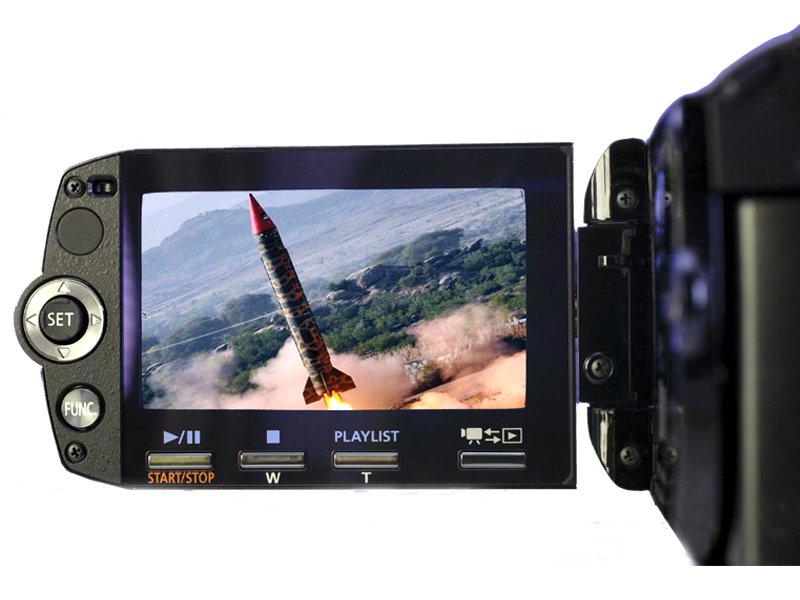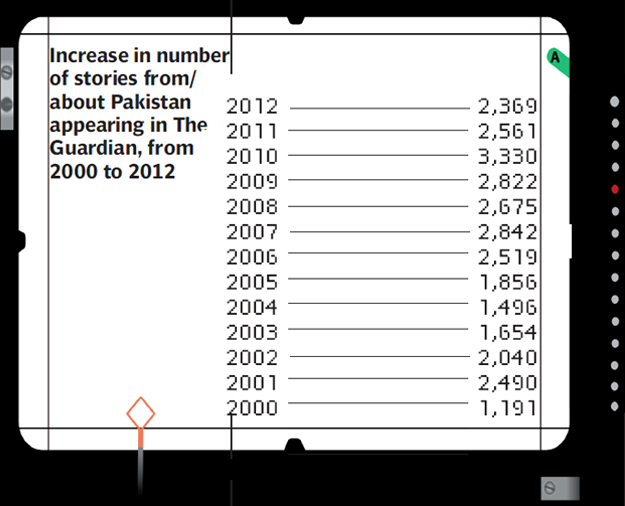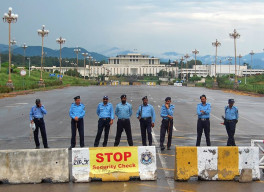
The country went through a complete image makeover following the 9/11 attacks. It transformed from a relatively unknown country, with its biggest claim to fame being India’s neighbour, to an important player in the global community. The post 9/11 Pakistan is of immense consequence – it is a country that possesses nukes and is an ally in a war, fighting against extremist elements that are gaining momentum in its own backyard.
The shifting landscape has made the country a hot favourite for the international media, with the number of foreign correspondents coming to the country more than doubling in the past decade. According to the Press Information Department, the number of residing-journalists has risen from approximately 130 in 2001 to 250 in 2012 while the number of visiting journalists has risen from 30-40 to nearly 400 as of today. Along with sending reporters to the country, a number of foreign publications also hire local reporters to report news from Pakistan.

Source: Press Information Department, Pakistan
Stories from Pakistan also began to occupy a significant space in most international publications. For example, a search on The Guardian’s website for stories from/about Pakistan shows an increase from 1,191 stories in 2000 to 2,369 stories in 2012.

Source: Press Information Department, Pakistan
A closer look at the nature of the stories reveals that the largest number of stories about Pakistan appeared in the ‘World News’ section, featuring hard news events like terrorist attacks, political developments and international relations while the smallest number of stories appeared in the ‘Law’ section of various international newspapers. The ‘Travel’, ‘Lifestyle’, and other sections featuring soft-stories also contained disproportionately fewer stories.

Source:http://www.guardian.co.uk/search?q=Pakistan+&date=date%2F2012
____________________________________________________________
Watch related videos on Vimeo here:
• Foreign correspondents in Pakistan - Part I
• Foreign correspondents in Pakistan - Part II
• Foreign correspondents in Pakistan - Part III
• Foreign correspondents in Pakistan - Part IV
• Foreign correspondents in Pakistan - Part V
____________________________________________________________
While the coverage of sensitive issues by the foreign media has been applauded for being thorough, credible, and accurate, the range of stories has often been criticised for being too narrow and showing a skewed picture.
“The foreign media writes about issues that people want to read. Some of us might not like what they write, but what they write about the country is fairly realistic and accurate,” says journalist Najam Sethi.
According to Taha Siddiqui, an Islamabad-based journalist reporting for foreign news outlets, such stories are preferred by international editors and tend to get more coverage because they are relevant to the global audience. Given that Pakistan is a nuclear-armed ally in the war on terror, located next to Afghanistan, the country’s stability is a key concern for everyone.
“It’s not actually a bias towards certain stories, but the baggage that comes with the country’s reality,” elaborated Sethi.
Cyril Almeida, assistant editor at Dawn.com, feels that there is not much difference between stories from Pakistan that make headlines in the local media, versus those in the international media. However, he points out that in the case of international publications, not only are stories met with constraints of space and time, but are also competing with stories from across the world. Therefore, a story has to be truly “violent, newsworthy or uplifting” to actually make it to the news pages.
“We should be more concerned about the product [Pakistan], rather than its image. We should fix the product rather than obsess about its image,” he said.
In comparison, Almeida stated that a country like India gets much more coverage by virtue of its size, economic strength and tourist attractions, whereas in comparison there aren’t many feel-good stories to write about in Pakistan these days.
On the other hand, Press Trust of India correspondent Rezaul Hassan, feels that it is not a lack of reporting but certain trends that the international media tends to highlight. He cites the portrayal of fashion shows as a combat mechanism against terrorism in Pakistan as one of the examples of a story that most foreign organisations focused on a couple of years ago.
“But Pakistan is so much more. It is also a country transitioning towards a democratic rule. It is a country where the president has completed his tenure despite all odds. So many young people are determined to make something out of this country despite the problems with the economy and extremism and more needs to be written about all this,” he said.
National Public Radio host and author of “Instant City: Life and Death in Karachi”, Steve Inskeep agrees that the international coverage of the country, while often very good, is too narrow. He states that nearly all of the stories revolve around bombers and the Taliban and the ISI. While those stories are vital, Pakistan has a lot more to offer.
“I do not think that a broader picture of Pakistan would always be more ‘positive’. There are many problems, and many kinds of violence, tremendous poverty, inequality and problems of sustainability and democratic survival. But the picture can be fuller, more interesting and truer,” he said.
However, for foreign reporters, looking for a ‘bigger and broader picture of the country’, and the tedious process of reporting required by such a ‘big picture’, can be particularly challenging due to language barriers, security concerns and complex political and social realities of the country.
While being on the ground is important for journalists, most of them rely on stringers, fixers and interpreters for access to stories in areas like the Federally Administered Tribal Areas. Additionally, stringers can also play an important role in gaining access to sources and help acquire a more accurate understanding of the country’s customs, language and history.
According to Richard Leiby, bureau chief for The Washington Post, the qualities intrinsic to a good stringer are being good-natured, flexible and well-connected.
“Sometimes even a driver can open a window into the local culture and influence a story,” says Inskeep. He narrates his experience of watching cricket over dinner with his driver’s family, which helped him understand the rules and the local fascination with the sport – which gave him a fresh angle from which to view the story.
Language barriers
Lack of knowledge of Urdu and other local languages can often create difficulties in communicating with sources. Stringers and translators can be particularly helpful in such situations.
According to Inskeep, the only solution was to ask questions, and keep asking them till you were clear about an issue.
“While some people seemed suspicious and did not say all they knew, others were delighted to share their stories. No matter where you are in the world, if you are willing to listen, you hear the most amazing things,” he said.
Hassan recalls how people initially assumed his Urdu/Hindi skills to be perfect, since he belonged to India. This was far from the truth back then. But now, he claims that he can speak these languages as well as the locals.
He describes his term in Pakistan as one of the most “fertile periods” of his professional life but the journey has not been equally satisfying in personal terms. Restrictions on travel frustrate him the most.
Being one of the only two Indian journalists working in Pakistan currently, he has often encountered great trouble while getting visa extensions.
“There are times when I have been without a visa for up to six months,” he said, adding that it was unfortunate that such hindrances existed on both sides of the border.
“We try and look for stories that are different from ‘the story’ that everyone else is writing about,” says Michele Leiby, also a correspondent for The Washington Post.
But that is not always easy given the restrictions on foreign correspondents when it comes to travelling freely outside Islamabad and Punjab. Huge amounts of paperwork is required for such travels, which consumes a lot of time, often at the cost of dropping a story.
While talking to the average Pakistani, or getting really close to a story might be challenging for foreign reporters due to security reasons and language barriers, access to important government, military and bureaucratic officials is often easier.
“Pakistani political leaders and officials are sensitive, I think, about the image their country presents to the world, so they tend not to totally ignore calls,” says Leiby.

Hassan, who has faced unusual difficulties in getting information from the government, shares a completely different opinion. “There are people who flatly refuse to talk to you, or even share the more harmless kind of information, simply because you are Indian,” he said.
Reporting for a foreign publication also allows for a certain level of freedom and fearlessness in stories – a rare luxury for local reporters. While local journalists might have better access, the deteriorating security situation for journalists in the country prevents them from actually covering those stories, elaborates Rob Crilly, the Pakistan correspondent for The Telegraph. He cites stories on Balochistan, blasphemy, religion and the workings of ISI as some of the dark corners upon which foreign reporters can tread relatively freely.
“We work here as if we were working in the United States. We are not under risk of being abducted, jailed or censored. The worst that can happen to us for doing these stories is that we will get kicked out,” says Leiby in agreement.
The threat to journalists in Pakistan applies more to local reporters rather than to us and I have immense respect for men and women here who continue to do their job despite such difficulties, added Mrs Leiby.
Covering Pakistan: the experience
“Spend two weeks in Pakistan: you are confused. Spend one year in Pakistan: you are more confused,” says Leiby, who has been in the country for the past one year along with his wife.
He added that the cultural adjustments would “blow your mind away”, if one did not have any previous experience of working in the Muslim world. For Leiby however, the adjustment was not so drastic due to his previous assignments in Gaza, Iraq and Egypt.
“My major perception adjustment was to the idea that everyone would hate me as an American. That is indeed far from the truth,” he explains how some of his pre-conceived myths were dispelled upon arrival.
There were exceptions like the time he stepped out to the nearby petrol station to get a few quotes for a story where someone inquired what branch of the Central Intelligence Agency he belonged to. When he responded, “No sir, I work for the Washington Post,” the man retorted: “Isn’t that the same thing?” Leiby recalls with a laugh. Such incidents however, are an exception rather than the norm, he added.
But the suspicion towards British reporters is lesser, which makes the job relatively easier for them, as compared to an American reporter or one from any other European country, says Crilly. Having worked here for the past two and a half years now, he recalls the transition as a “relatively easy one”.
“You can say a lot of bad things about the British Empire but one of the things it has done is give us a common language, a mutual love for cricket and a cup of tea. That has opened doors for me in many ways,” he said.
For an Indian journalist, covering Pakistan is “a dream job”, says Hassan who has been doing so for the past five years. For him the choice of working here was extremely straightforward as the country figures prominently in Indian politics and diplomacy and people back home love reading about it. However, there was much warning from fellow countrymen for these journalists before they came to Pakistan about the unstable security conditions and people from agencies following him around.
On their first night in Pakistan, Hassan and his wife returned to their hotel safely late at night. Despite all they had heard, the couple decided to go out and discover for themselves. “Such small things highlight the difference between perceptions and reality,” he said.
For Michele Leiby, the surprise came at the sight of armed men and the abundance of weapons everywhere.
“Initially, I was surprised to see even the guard outside a Nando’s (a foreign food chain) outlet holding a gun. But with time, you get used to these things,” she added with a smile.
Her husband recalls the first sound of gunshots he heard in the country, which were later discovered, to his amusement, to be part of a wedding celebration around the street corner.
A hospitable people
The warmth and generosity of the Pakistani people struck a chord with all foreign correspondents. “Wherever you go, there is a cup of tea, often accompanied by an invitation to lunch. The hospitality still overwhelms me,” says Crilly.
Michele Leiby also feels that she has learnt the true meaning of warmth and hospitality through the people in Pakistan. She fondly recalls a family in the refugee camps in Jalozai, who opened their hearts and homes to them despite having nothing aside from their tent, a cot, and a few pigeons.
Despite the warnings and potential bumps and dead ends, the ride for a foreign journalist reporting in Pakistan is an exhilarating one. “You come to Pakistan, it feels like you are driving at 80 miles/hr every day. When you go back home, you go back to driving at 20 miles/hr. It is such an incredible rush being here”, says Hassan.
Strange tales from Pakistan
Pakistan Loving Fatburger as Fast Food Boom Ignores Drones – Published in January 2013 by Bloomberg, this article traces the growth of American franchises and increase in consumer spending in Pakistan over the past few years. However, the headline and the parallels drawn between enjoying food at American chains and terrorism drew a large amount of criticism, especially over social media
Bin Laden City Abbottabad to build amusement park: Published in AFP on February 2013,the story is about the government plans to build an amusement park in the city of Abbottabad. However, the reference to Abbottabad as “Bin Laden City”, has been criticised for limiting the city’s history and identity to the final refuge of a terrorist.
In Pakistan, underground parties push the boundaries – Published in August 2012 by Reuters, this report juxtaposes the culture of partying, drinking and dancing by young people against a backdrop of rising extremism and Talibanization in Pakistan. It received a lot of criticism for misquoting sources and drawing parallels between two exaggerated extremes in the country.
Designers shrug off militant violence for Pakistan’s fashion week: A series of stories ran in 2009 in several foreign newspapers, covering Pakistani fashion weeks and portraying it as an alternative mechanism for combating the increasing extremism in the country. This kind of coverage received criticism for juxtaposing two different extremes with each other.
Stories covered exceptionally well by foreign media
1. Osama bin Laden’s death: How it happened: The level of detail, precision and openness in the reporting on the bin-Laden operation by the foreign publications remains unmatched by local newspapers. The shortcomings of the ISI and the Pakistani army have also been addressed openly, a subject that remains sensitive for local papers.
2.Karachi:Pakistan’s bleeding heart: A detailed story on the violence in Karachi, incorporating perspectives from the various stakeholders and mapping out the various sectarian and political clashes in the city.
3. Pakistan’s secret dirty war: The piece sheds light on the conflict in Balochistan, the issues of missing persons and the insurgency in the area. The reporting in the story was extremely detailed and highlighted an important issue in the country, mainly ignored by mainstream media at the time.
4. Cheating spouses keep Pakistani private detectives busy: An unusual and different story detailing the woes of women in Pakistan, who hire detectives to keep track of their spouse’s whereabouts and activities. The story breaks free of the usual pattern of terrorism and bombs and chronicles the dilemmas of an average Pakistani.
5. In Pakistan’s Taliban territory, education is a casualty of conflict: A profile of a school in Waziristan which continues to function despite all odds, the story offers a unique perspective into the area, unlike the usual tales of bombs and destruction that emanate from the region.
(WITH ADDITIONAL INPUT FROM VAQAS ASGHAR, WAQAS NAEEM AND FARMAN ALI)
Published in The Express Tribune, February 24th, 2013.
COMMENTS (27)
Comments are moderated and generally will be posted if they are on-topic and not abusive.
For more information, please see our Comments FAQ


1730965998-0/BeFunky-collage-(27)1730965998-0-165x106.webp)
1731933289-0/BeFunky-collage-(68)1731933289-0-165x106.webp)





1731929357-0/Express-Tribune-(6)1731929357-0-270x192.webp)







Totally agree on this one. Excuse the pun, but I am sick to death always hearing about Taliban, nuclear Pakistan, military coup, corrupt government. There is so much more POSITIVE THINGS that go on IN PAKISTAN. This propaganda machine of constant negativity when it comes to Pakistan should end. The average person in Pakistan is very warm and hospitable. They are just not given much chance or opportunity to shine. I'm telling you, the average person in Pakistan is very tolerant and much more capable and stronger than other nationalities.
This is why I read ET....for the fresh journalism. I loved this article, thank you very much.
@Imdad Ali Shah-Dubai: "the game will change 360 degree!"
You orobably meant 180 degrees. Do check out what a 360 degree change means.
"For an Indian journalist, covering Pakistan is “a dream job”, says Hassan who has been doing so for the past five years. For him the choice of working here was extremely straightforward as the country figures prominently in Indian politics and diplomacy and people back home love reading about it."
It is interesting that he sees himself only as an Indian journalist - which is great. But I am sure some degree of his safety owes itself to the fact that he is Muslim. Would he have found it easy to find a temple where he could pray or openly celebrate, Holi and Diwali? (We are able to do that in US by the way). Equally relevant is the type of social life his wife would have got if they were vegetarian Hindus.
:"“We should be more concerned about the product [Pakistan], rather than its image. We should fix the product rather than obsess about its image,” he said." Cyril nailed it. Lord knows India has plenty of problems. But we cannot and should not try to cover them up just to protect our image. We talk about them openly with a view to finding solutions. The recent gang-rape n Delhi is one example.
"In Pakistan, underground parties push the boundaries – Published in August 2012 by Reuters, this report juxtaposes the culture of partying, drinking and dancing by young people against a backdrop of rising extremism and Talibanization in Pakistan."
The real story is not that such parties exist but that they need to be underground. It was also interesting that the people quoted in those stories went to some length to distance themselves from the so called fayyashi. Though they did not and could not deny the direct quotes attributed to them, they complained that they had not been presented in the right context.
@Bangladeshi:
Its a similar symptom experienced by indians. The surpassing of one's country over others magically. Granted pakistan is the peak of its troubles at the moment, one thing I can assure you without any supporting material is that Bangladesh is never going to be close to Pakistan militarily. Economically yes it may.
Also your immediate threat is not pakistan but India so look first who is planning to eat you alive before dreaming of becoming anything close to a regional power.
@Malik Hamza: good dream but u better wake up. u people can never ever and ever in every aspect go ahead of Pakistan.
I agree Bangladesh can't beat Pakistan in terrorists attacks.
@Pakistani: Pakistan is a beautiful country of peace loving people.
I wonder how many times more people will get killed in Pakistan every day, if it were not a peaceful country. Only about 200 Shias killed in Jan and Feb 2013.
WORLD report says BANGLADESH WILL SINK BY 2035 . ur whole country will be under water. good dream but u better wake up. u people can never ever and ever in every aspect go ahead of Pakistan.
@Bangladeshi Good for you. Feel better now? Sleep tight tonight.
Bangladeshi is basically Indian under pseudoname. . We have good feelings for our brother. Good Luck Bangladesh!! . We have come out of bad times many times and I am sure Bangladesh will come out winning from its current politicial turmoil. . We Pakistanis are your well wishers!
@Bangladeshi: Then why are there about a million illegal Bangladeshis working in Pakistan?
@ bangladeshi ! lets wait for 2020 and lets see whos the fittest :P
dude just wait and see 1) Gwader port 2) Thar Coal 3) Rizo Diq
just one Project complete. the game will change 360 degree!
@Bangladeshi: Do you need to share your two pennies of wisdom here?
@Bangaldeshi - you are also leading Pakistan in spelling mistakes
@ Bangladeshi. We wish u all the best. But if your wish is to have strong army/military then there r better chances that you will never grow, just like Pakistan. So wish and make efforts for strong education, health, economy, sports.......
@The Khan, totally agree.
As far as I am concerned, foreign media should just leave us alone. They have a lot of their own issues to worry about. From psycho shootings to abortion laws to debt issues to rape to roits. Leave us alone!
Visitors r most welcome though.
A well written article Pakistan should now focus on more UNDERGROUND PARTIES DRINKING and DANCING More of Fashion Shows and obviously women should be given more liberty. Otherwise it is not long even DHA in Karachi will look like Waziristan and Afghanistan with burqa clad women roaming around and people with long beard and AK-47 punishing other Muslims for not being good Muslims.
at BANLADESHI...keep dreaming dear,you will not even get close to us the bad last five years donot mean we lost everything.ya we did lose some but the next 5 years you will be seeing people from under developed nation trying to settle in but will not be allowed to settle in
Pakistan is a beautiful country of peace loving people. It is still unexplored heaven...long live my Country..
@Bangladeshi : You guys should learn the spelling of leading first .. then think of it
Really nice to see something nice written about Pakistan from foreignness. Well done like always ET.
A Peshawary
Lets not forget Daniel Pearl in all the hoopla.
I so loved this read. Been days I have read something like this for Pakistan, especially hospitality section. Whoa! Bringing some positive energy.
Why would the Indian guy complain exactly? he is living in a posh colony of Islamabad surrounded by beautiful forests.
I keep telling my friends, "There is no such thing as bad publicity." Pakistan you are now a global player.